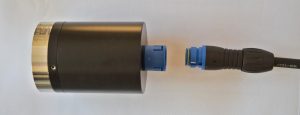Aquation SDI-12 PAM Fluorometer Sensor
Description
- Aquation SDI-12 PAM Fluorometer Sensor for plant physiology and chlorophyll content studies
- SDI-12 connection to control system for remote and automated use, e.g. SCADA
- Fluorescence sensor with cable located at base of unit
- Water resistant sensor (waterproof to 3 m/10 ft)
- Measures variable fluorescence of photosystem II using PAM technique
- Returns Fo, Fm and Fv/Fm values
- Calculates relative chlorophyll index that correlates with chlorophyll concentration
- Measures temperature in sensor
- User manual and software supplied

Aquation SDI-12 Fluorescence Sensor
Benefits/advantages:
- SDI-12 enables operation using industrial control systems,
- Fully waterproof sensor for use in the greenhouse or field,
- Low power consumption,
- Sensor can be easily disconnected for easy installation,
The Aquation SDI-12 PAM Fluorometer Sensor is designed for unattended continual use in the field or greenhouse. SDI-12 is a communications technique suitable for external control that is widely used in industrial and process installations. It requires a wired connection to the controller, and a 12V DC power supply. An optional clear light pipe extension enables measurement of samples 0.3m from the sensor. This is particularly useful for long term measurements where shading of the sample must be avoided. The Aquation SDI-12 PAM Fluorometer Sensor is functionally similar to other Aquation Classic fluorometers.
Application:
Using the Aquation SDI-12 PAM Fluorometer Sensor will provide regular measurements of photosynthetic efficiency throughout the day and night. Values of your plants of interest are best compared against reference plants of the same species – differences in photosynthetic efficiency during the day between these plants are directly related to environmental condition. By providing the most optimal environmental conditions for your reference plants (water, nutrients, sunlight), a measured decline in photosynthetic efficiency of treatment plants can then be directly linked to whatever they are missing. For example, by providing less water to the treatment plants, any difference between the reference and treatment plants will indicate water deficiency. The big advantage is this fluorescence-based technique will show differences several days before changes can be detected by eye. So you can apply more water, grow more crop and avoid losses.
Specifications
- Unit of measure: relative fluorescence units
- Range: 0-4000
- Automatic ranging and autozero functions
- Relative chlorophyll index (function of gain and Fo)
- Temperature in ºC
- Light sources: 470nm LED (excitation), white (saturation and actinic), 735 nm (far red)
- Sensor housing: acetal, stainless steel 316
Please use the Contact Form to make further enquiries.




